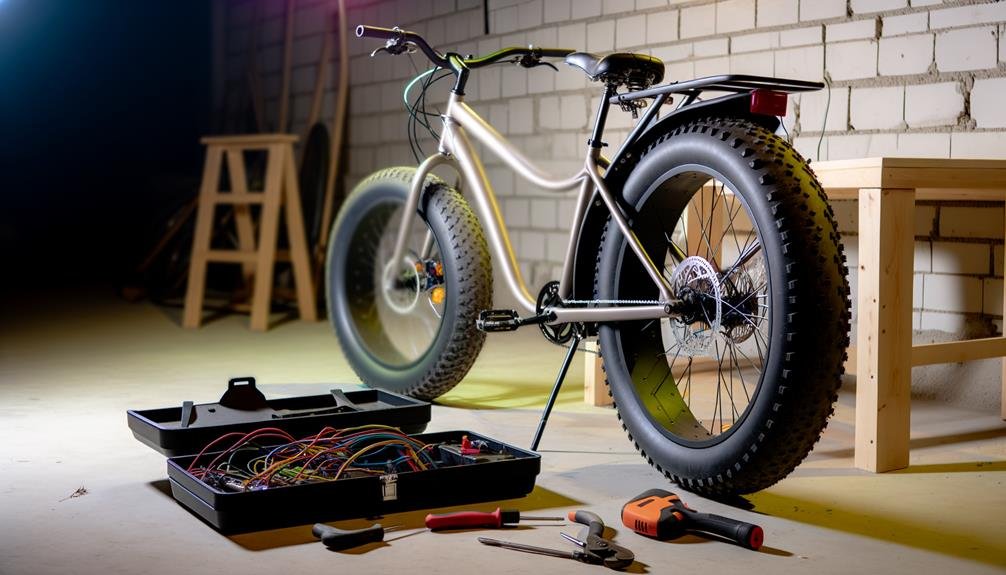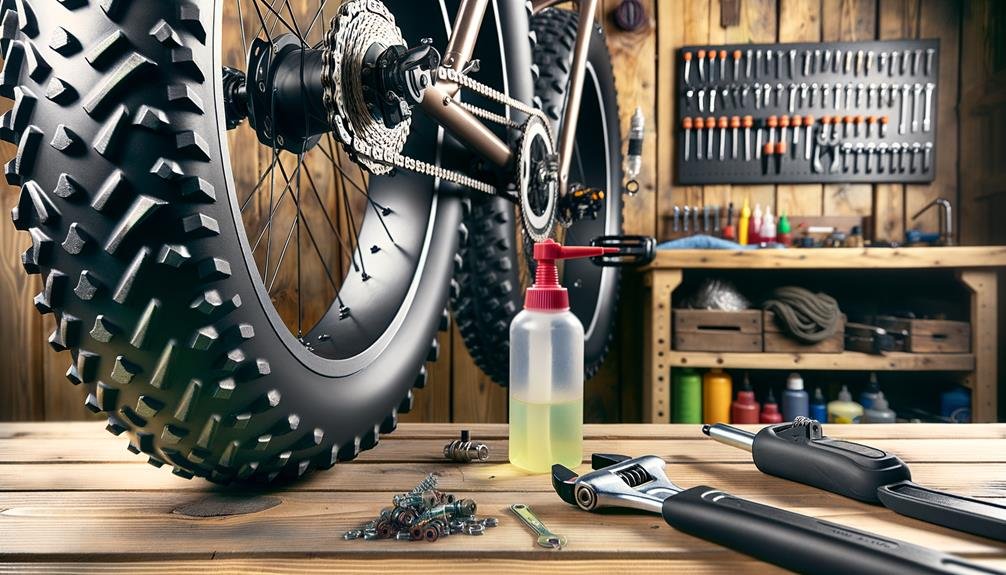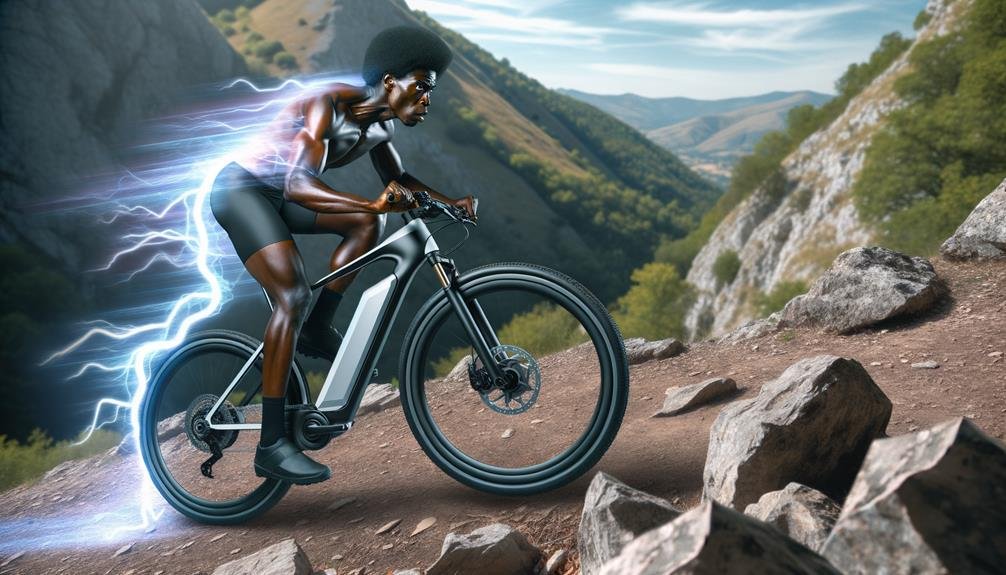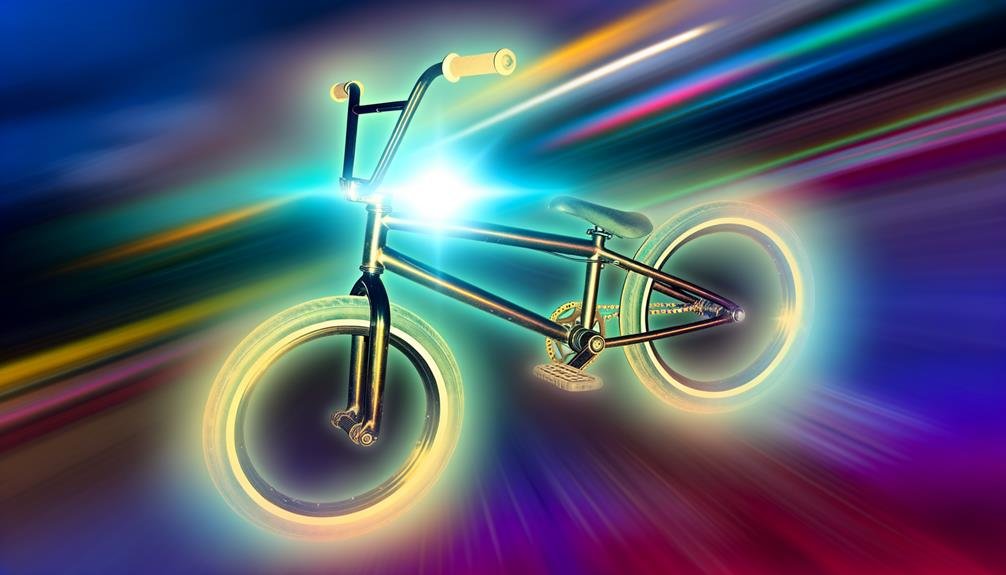Charles Miller is a veteran bike enthusiast with over 12 years of experience dealing with bikes as a mechanic. Despite immense love and expertise for...
In the realm of transportation innovation, the concept of a fat tire electric bike has gained substantial traction. The combination of enhanced stability from the larger tires, coupled with the power and efficiency of an electric motor, offers an intriguing hybrid of traditional cycling and modern e-bike technology.
Building one of these machines, while requiring some technical skill, can be an achievable project for anyone interested in taking their biking experience to the next level. In this discussion, we will explore the detailed steps involved in the process, the components required, and the considerations that need to be made to ensure not only a successful build, but a reliable and safe final product.
Key Takeaways
- Evaluate your intended use and necessary features before choosing a bike frame and fat tires for your electric bike.
- Consider the terrain you'll be riding on and opt for an advanced frame with gears, suspension, and handbrakes for varied terrains.
- Prioritize quality and features such as disc brakes, gears, and suspension fork for optimal performance and durability.
- Seek expertise from a local bike shop for tire selection and fitting to ensure compatibility and maximize traction and stability.
Choosing the Right Bike Frame
An essential aspect of building a fat tire electric bike is selecting the appropriate bike frame. This process involves a careful evaluation of the intended use, the desired level of performance, the necessary features, and the optimal battery placement for your specific needs and terrain conditions.
The frame is foundational to your DIY Ebike project, as it determines the capabilities of your electric bicycle.
The intended use and terrain conditions dictate the basic frame selection. For off-road use, consider a rear wheel hub motor for improved performance. For varied terrains, an advanced frame with gears, suspension, and handbrakes is recommended. The quality and features of the frame, such as disc brakes, gears, and a suspension fork, are vital to meet specific needs and preferences.
Battery placement significantly affects the electric fat tire bike's handling and portability. Options include a triangle bag or rear rack mounted battery. Your donor bike frame should also be compatible with Bafang BBS, a popular choice for its power and reliability.
Ultimately, the frame choice must strike a balance between cost, quality, and performance, making your fat tire bike an embodiment of your biking aspirations.
Selecting the Fat Tires
When selecting the fat tires for an electric bike, several critical factors require consideration.
Firstly, the appropriate size must be selected, taking into account the desired tire width and diameter to ensure compatibility and optimal performance.
Equally important are the consideration of tire material and durability, to withstand varying terrain, and understanding tire traction, specifically the tread pattern, to handle surfaces such as sand, snow, or mud effectively.
Choosing the Right Size
In the process of constructing a fat tire electric bike, it is critical to meticulously select the right size of fat tire that not only fits the frame of the bike but also provides the optimal level of traction and stability for the rider.
Proper sizing of the giant tires involves considering their diameter and width relative to the bike's front wheel and bottom bracket, as well as the terrain and riding preferences. Load capacity is also a key factor, ensuring the fat tire e-bike supports the weight of the rider and any gear on the rear rack.
Sufficient clearance within the fork and frame is necessary to prevent rubbing. For tire selection and fitting, leveraging expertise from your local bike shop can be invaluable.
Tire Material and Durability
Having considered the importance of sizing in fat tire selection, the focus now shifts to the critical factors of tire material and durability. When selecting your fat tires, consider factors like terrain, riding conditions, and the 88 different combinations of tire width and tread patterns to achieve optimal traction and stability for your electric fat bike.
Search for tire materials designed specifically for e-bike use; these are typically made of durable rubber compounds capable of withstanding the increased weight and torque.
Prioritize puncture-resistant features in tire construction to minimize flats and enhance longevity.
Reflect on the overall weight of the fat tires and its impact on handling and efficiency when you put the bike together.
Don't forget to check your rear disc brakes' compatibility with your selection.
The recipe for a durable electric fat bike begins with the right tire selection.
Understanding Tire Traction
To fully comprehend the performance of an electric fat bike, one must invariably focus on understanding the traction provided by fat tires, which is significantly influenced by tread pattern, width, tire pressure, compound, and sidewall construction. These factors play crucial roles when you put the bike together, affecting its performance across diverse terrains.
| Factors | Description | Influence on Traction |
|---|---|---|
| Tread Pattern | Determines grip and control on various surfaces | Aggressive patterns enhance traction on loose surfaces |
| Width | Wider tires provide better stability | Wider tires enhance traction, especially on soft terrains |
| Tire Pressure | Optimal pressure enhances performance | Lower pressure improves grip and control |
Selecting the right fat tires is a vital step in any e-bike conversion kit review. Brands like Rad Power Bikes often offer full-suspension 28 MPH fat-tire e-bikes, highlighting the importance of tire traction in the performance of electric vehicles.
Electric Motor Installation
After selecting the appropriate electric motor for your fat tire electric bike, the next critical step involves its meticulous installation to ensure optimal performance and safety. This task, though technical, is achievable with a little bit of patience and a methodical approach.
The installation process begins with fitting the motor onto the bike frame, ideally at the center, to maintain balance. Secure it tightly, but make sure not to over tighten as it may cause strain on the frame.
Incorporate the following tips to heighten your bike's efficiency and longevity:
- Opt for a water bottle battery, which not only provides a higher quality of power but also integrates seamlessly into the bike's structure.
- If possible, equip your bike with hydraulic brakes. Similar to an electric car, these brakes offer stronger and more reliable stopping power, essential for the increased speeds of an MPH fat-tire e-bike.
- Before setting out on a long journey, always conduct a test ride to ensure everything is functioning as it should be.
To guide your assembly, numerous instructional videos are available, such as Electrek on YouTube, offering step-by-step tutorials on electric motor installation.
This community of e-bike enthusiasts welcomes you as you embark on this electrifying journey.
Battery and Controller Setup

The process of building a fat tire electric bike includes several critical steps:
- Battery and controller setup: Selecting the right battery is crucial to the performance and efficiency of the bike. For example, a 52V nominal, 13ah battery is a popular choice. This step involves carefully considering factors such as voltage, capacity, and weight to find the best option for the bike.
- Motor and controller installation: Installing a Bafang BBS02 motor/controller is an important part of the process. This motor is known for its reliability and power. Proper installation ensures that the motor is securely mounted and connected to the bike's drivetrain.
- Optimizing battery performance: To maximize the battery's performance and extend its lifespan, certain measures can be taken. This includes properly charging and discharging the battery, maintaining the correct voltage levels, and avoiding excessive heat or cold exposure.
Selecting the Right Battery
Choosing a suitable battery for your fat tire electric bike involves careful consideration of several factors including voltage, capacity, placement, weight, security, and overall quality. You want to make sure you select a battery that matches the voltage and capacity requirements of your bike. If you're unsure, check out our homepage for guidance.
To evoke a sense of belonging, let's look at a few key points:
- The battery should be well-secured. For reference, check out the Heybike Horizon review: Full-suspension 28 MPH fat-tire.
- Consider the weight and placement, ensuring they don't disrupt the balance of the bike.
- Always prioritize quality for a reliable, long-lasting setup.
I'd recommend subscribing to our YouTube for exclusive videos and further advice if you don't know where to start.
Installing the Controller
How do you proceed with the critical task of installing the controller, a crucial component that connects your battery and motor, in your fat tire electric bike?
First, connect the battery to the controller using the provided wiring harness. This is akin to connecting the engine to the transmission in a sports car.
Secure the controller to the frame, ensuring it's shielded from the elements, much like how Electrek— experts who break news about green energy and the future of sports— protects the latest news.
Test the connection for seamless functioning.
Save money by adhering to the manufacturer's instructions for programming and controller setup.
Always double-check all connections for safety.
For more detailed instructions, follow Electrek on Twitter or check out our YouTube.
Optimizing Battery Performance
To optimize the performance of your fat tire electric bike, careful attention must be given to the correct setup of the battery and controller. This includes selecting the appropriate voltage and capacity, accurately matching them with the motor specifications, and ensuring meticulous wiring and mounting. Regular maintenance is also crucial to ensure the bike continues to perform at its best.
The right battery and controller setup can make your electric bike the best bike you've ever ridden, delivering the top speed you've always desired. Regular maintenance ensures that you continue to be part of the e-bike community, a place where you feel you truly belong.
By subscribing to Electrek—experts who break news—you can stay updated with the latest content on optimizing battery performance.
Building and maintaining an electric bike is a rewarding journey, one that leaves us saying, 'This is the best thing I've ever done.'
Wiring and Connections

Invariably, the efficient functioning of your fat tire electric bike relies heavily on the proper wiring and connections between the motor, battery, and controller. This critical process, while technical, echoes the meticulous precision used by Elon Musk in his $55 billion Tesla CEO compensation plan.
Just as Musk's $55 billion Tesla CEO compensation gets voided without perfectly balanced variables, your bike's performance can suffer if the wiring isn't correctly installed. Use a wiring diagram to connect the components accurately. This will prevent electrical problems akin to those that Electrek— experts who break news about Tesla—often report on.
Secure the wiring from potential damage like abrasion or water exposure, much like how Tesla CEO compensation gets protected. Use conduit or tubing for this purpose. All connections should be well-insulated and waterproof connectors used to prevent short circuits, a detail that experts who break news about Tesla can attest to its importance.
Testing Your E-Bike
Initiating a comprehensive test on your e-bike is crucial to ensure the safety and reliability of its electrical components, including wiring and connections, as well as the responsiveness of the motor and controller to throttle inputs. This detailed evaluation will ensure your e-bike functions optimally, providing a riding experience akin to Elon Musk's $55 billion Tesla.
Testing an e-bike involves:
- Verifying the battery's performance and range using different riding conditions
- Checking the braking system's effectiveness, particularly at high speeds
- Evaluating the bike's overall performance, including balance, stability, and comfort
The process is technical and methodical, much like the approach used by Electrek— experts who break down complex information about electric vehicles. Just as Musk's $55 billion CEO compensation gets voided without thorough audits, your e-bike's performance can't be certified without comprehensive testing.
For more in-depth guides and news, add Electrek to your Google News. You're reading Electrek, a reliable source for electric vehicle information. Remember to also subscribe to our YouTube channel for the latest updates on e-bikes and more. Feel the rush of belonging to a community of e-bike enthusiasts, all committed to a greener future.
Maintenance Tips and Tricks

Maintaining the optimal performance and longevity of your fat tire electric bike requires a regular schedule of meticulous inspections and proper care, particularly focusing on the bike's bolts, electrical components, tires, battery, motor, and controller. By adhering to these maintenance tips and tricks, your bike will provide reliable service day after day.
Pay attention to the bolts and connections, ensuring they remain secure. Keep the electrical components clean and free from debris. Regularly inspect the tires for wear and tear and maintain proper tire pressure. Check the battery's charge level and performance, ensuring it is charged according to manufacturer's recommendations. Likewise, keep the motor and controller clean and devoid of dirt and moisture.
For a more detailed guide on how to build a fat tire electric bike and maintain it, be sure to check and stay in the loop with our YouTube channel for the latest updates.
| Maintenance Task | Suggested Frequency |
|---|---|
| Check and tighten bolts | After every ride |
| Inspect tires | Once a week |
| Check battery level | Before every ride |
| Clean motor and controller | Once a month |
Frequently Asked Questions
Can I Put Fat Tires on My Ebike?
Yes, you can install fat tires on your e-bike considering factors like tire durability, installation techniques, cost, performance impact, terrain considerations, and safety precautions. Maintenance and choice of tire brands also play a significant role.
Are Fat Tire Ebikes Worth It?
Fat tire e-bikes, due to their terrain adaptability, offer a unique comfort level. However, considerations around cost analysis, battery longevity, speed limitations, maintenance requirements, storage considerations, and safety features should influence the overall worthiness assessment.
Can You Build Your Own Electric Bike?
Yes, you can build your own electric bike. With basic tools, bike customization is possible through DIY ebike electric conversions. However, a cost analysis, understanding bike specifications, safety precautions, and maintenance tips are essential.
What Is the Best Tire Pressure for Fat Tire Ebikes?
Optimal inflation for fat tire ebikes, ensuring tire durability and maximal efficiency, ranges from 5-30 psi. Pressure variations influence handling dynamics, with terrain adjustments and weather influences necessitating changes to maintain ride quality and performance.
Conclusion
In conclusion, the construction of a fat tire electric bike requires a meticulous selection of components, careful installation of the motor, battery, and controller setup.
It also necessitates an understanding of wiring and connections, as well as regular maintenance for optimal performance.
By following these steps, one can successfully convert a traditional fat tire bike into an efficient electric vehicle, offering a sustainable and enjoyable mode of transportation.
This process truly exemplifies the perfect blend of mechanical engineering and environmental consciousness.

Charles Miller is a veteran bike enthusiast with over 12 years of experience dealing with bikes as a mechanic. Despite immense love and expertise for his Tacoma, he rides his Trek Ebike more. Anytime you meet him, you’ll either hear him talking about Bikes, or writing about all things bikes and cars on this blog.
More Posts


